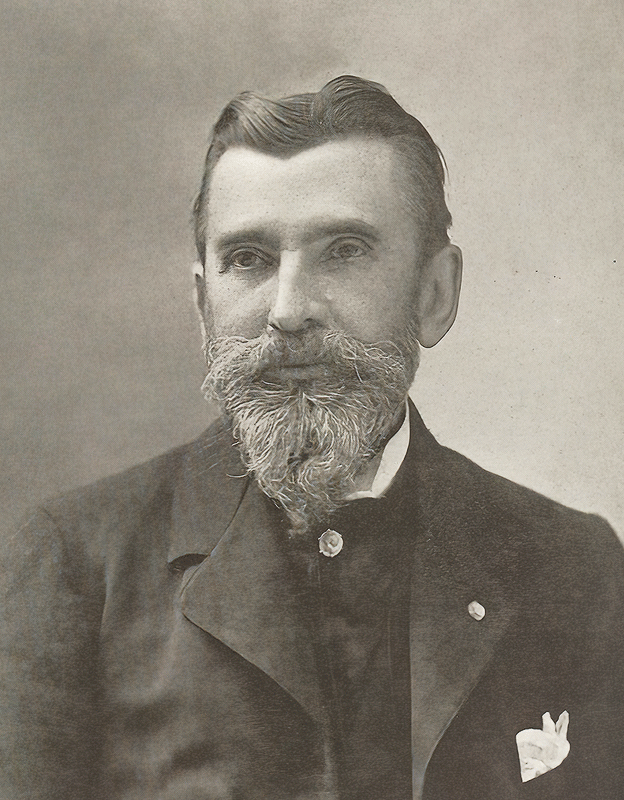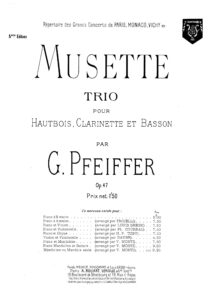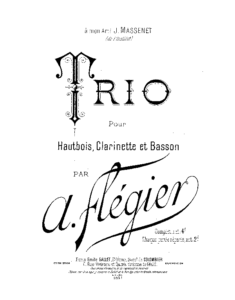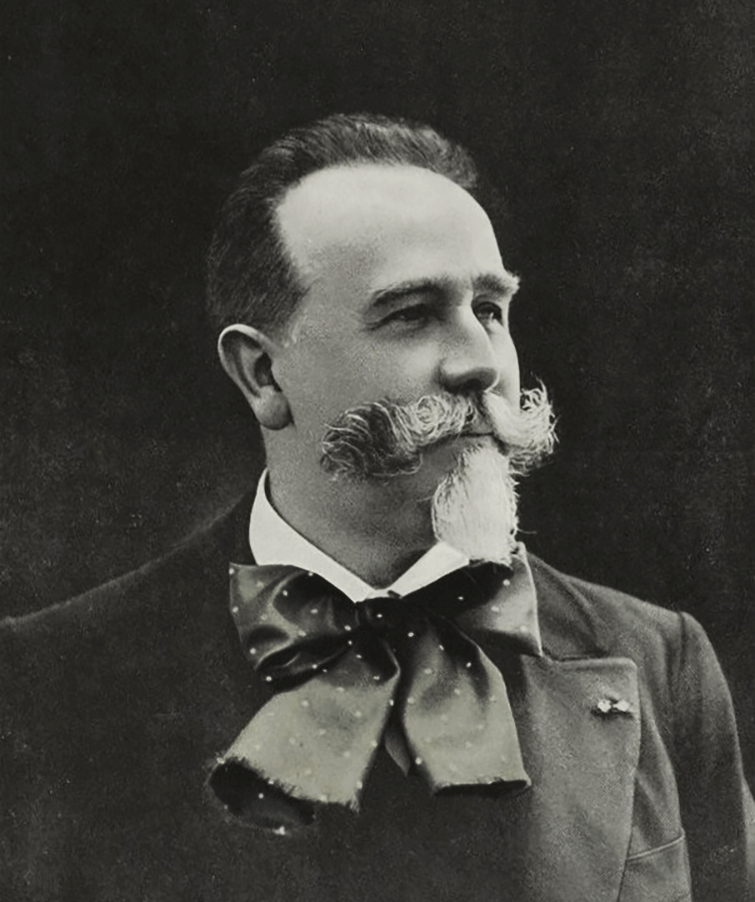Part I: The Nineteenth Century Trio d’Anches
Introduction & Prelude
The Trio d’Anches de Paris was formed in 1927 by bassoonist Fernand Oubradous (1903-1986); oboist Myrtil Morel (1889-1979); and clarinetist Pierre Lefebvre (1898-1983).
The conventional story about the Trio d’Anches de Paris is that it was one of the first of its kind and that it quickly commissioned and attracted new, modern pieces for it to perform and record, all with the help of their Australian patron, Louise Hanson-Dyer. Suddenly composers were attracted to the all-reed trio of winds and other performing ensembles quickly emulated the Parisian group.
Mssr. Oubradous considered the combination of oboe, clarinet and bassoon to be the perfect sonic ensemble for woodwinds and promoted it as the equal of string ensembles (as the string quartet) and superior to the woodwind quintet as far as the ability to blend with each other. Oubradous also coined the name of the trio: trio d’anche.
However, it is less well-known that the Trio d’Anches de Paris started out in 1927 performing arrangements of Mozart and Bach created by Fernand Oubradous for their performance. It took about six years (to 1933) before contemporary works began to be written (or dedicated) specifically for the ensemble. Very little info has been distributed about the ensemble’s early years.
Parenthetically, as a grad student bassoonist at Indiana University, this author studied for two semesters with bassoonist Mordechai Rechtman, principal bassoonist with the Israel Philharmonic. Rechtman had studied for a while with Fernand Oubradous, and included a few of the French bassoonist’s written exercises in his instruction. So I feel a tiny, almost-filial connection with the Frenchman.
Naturally, a new ensemble steeped in French culture, would have done some research into other works already written for their ensemble. But works that the players of the ensemble might have heard in live performance (such as the trios of Villa-Lobos or Schulhoff) never entered the ensemble’s repertoire.
The first works written for or dedicated to the Trio d’Anches de Paris were:
- Pierre-Octave Ferroud – Trio en Mi for Oboe, Clarinet and Bassoon (1933)
- Eugene Bozza – Fughette, Sicilienne, Rigaudon (1933)
- Fernande Decruck – Capriccio (1933), the first of seven trio d’anches written for her friend, Fernand Oubradous
- Darius Milhaud, Pastorale, Op. 147 (1935)
- Henri Barraud Trio (1935)
- Jacques Ibert Cinq Pièces (1935)
More recent research in the literature of the reed trio, however, shows that there were a number of composers during the nineteenth and early twentieth century (specifically in the 1920s and early 1930s) who wrote works for the reed trio before the Trio d’Anches de Paris began its own promotion of new works for the ensemble. Very little information about these works has been shared in any organized fashion before. This is likely the first full review of works created before the popularity of the Trio d’Anches de Paris, at least in English.
The rest of this series is in two parts. First, we continue with a discussion of the nineteenth century reed trios. Then, in a second post, we’ll continue with a list of those works of the 1920s and 1930s that create the foundation for other earlier trio ensembles and helped create a musical mileau that may have helped the Trio d’Anches de Paris to succeed.
Editorial Note: As mentioned above, the term “trio d’anche” was coined by Fernand Oubradous for the use of his own trio ensemble. This term is now used generally to cover all reed trios consisting of oboe, clarinet and bassoon. Technically, those trio d’anches written before Oubradous created the term would be correctly called reed trios for oboe, clarinet and bassoon. For these blog posts, however, we will used “reed trio” and “trio d’anche” as equivalent terms for the same instrumentation.
Since Paris was pretty much the musical capitol of Europe, it’s not a surprise that some of these earlier wind trios were by French composers, but there are also a collection of Swiss, German, Austrian, American, Belgian, Swiss, and other composers in the early history of the reed trio that are little known, even though they may make some excellent additions to a modern trio d’anche concert.
First, we will look at the Nineteenth Century contributions to the reed trio. But, before we do that, we seem to have a pretender to the throne of First Trio d’Anche.
Did Jean-Xavier Lefèvre write the First Reed Trio?
Jean-Xavier Lefèvre, the Swiss clarinettist and composer (born in Lausanne, Switzerland on March 6, 1763; died Paris, November 9, 1829) has been touted by a few as the first composer for a work for oboe, clarinet and bassoon. (Just to be clear, we are NOT talking about Charles Edouard Lefebvre (1843-1917), composer of the Suite, Op. 57 (1884) for woodwind quintet.)
Jacqueline Bretz in her excellent dissertation about the trio d’anche claims that Jean-Xavier Lefèvre wrote the first trio d’anche, which was published by the Paris firm of Janet and is now out of print. Her footnote shows that she is repeating info made by James Gillespie’s own research, The Reed Trio: An Annotated Bibliography of Original Published Works. (A now out-of-print dissertation.)
Searching the Gillespie document via Google books, we find the two critical sentences about this piece:

Very likely, this refers to Lefevre’s Simphonie Concertante Pour Hautbois, Clarinette et Basson avec Accompagnement d’Orchestre, which is for oboe, clarinet, bassoon and orchestra, now published in a modern orchestra reduction by Armelin Music in Padua (Padova), Italy. [See https://www.armelin.it/catalogo/simphonie-concertante-3/] This, of course, would not be a chamber music piece and would not qualify as a reed trio, although it could conceivably be a delightful sinfonia concertante.
Other than this sinfonia concertante, the only trio using three reed instruments by Lefevre, according to Grove Music Online, are Six Trios for 2 clarinets and bassoon. It is possible that one of the parts could have been performed on oboe, especially if the clarinet parts were printed in C instead of B-flat as was frequent then, but to consider this a trio d’anche as we define them would be unconvincing.
To add to the mix, there is also a Simphonie Concertante pour Clarinette ou Hautbois et Basson dedicated to X(avier) Lefèvre by Jacques Widerkehr, which, with a quick glance at the elegant title page (with a florid presentation of the dedicatee), might be confused for a trio for oboe, clarinet and bassoon by Lefèvre. (Note also that this Concertante is for clarinet OR oboe plus bassoon.)
Jean-Xavier Lefèvre online biographies make no mention of any chamber work for oboe, clarinet and bassoon. Nor does Grove Music Online. WorldCat also has no record of a work for oboe, clarinet and bassoon by Jean-Xavier Lefèvre.
Gillespie also mentions the music publishing house Janet, which would be Janet et Cotelle, active from 1810 to 1836 in Paris. After Janet’s death in 1836, it took 2 years for the firm to restart as A. Cotelle in 1838. [Source: International Music Score Library Project’s list of Music Publishers.]
Could there be a lost work by Jean-Xavier Lefèvre for oboe, clarinet and bassoon? His record, historically, is thin. Personally, I don’t think the evidence is there.
Did Wilhelm Mangold Write the First Trio d’Anche?
(Johann) Wilhelm Mangold was born in Darmstadt on November 19, 1796 and died, also in Darmstadt, on May 23, 1875 and came from an active musical family of composers and performers. Wilhelm was a violinist and composer, studying with Abbé Vogler (who also taught Franz Danzi) and, in Paris, with one of the Kreutzers (probably Rodolfe) and at the Conservatoire (from 1815 to 1818) with Etienne-Nicolas Méhul and Luigi Cherubini. He became Kapellmeister in Darmstadt from 1825 to 1858 where he introduced Beethoven’s symphonies to Darmstadt in the early 1830s and also widened the operatic repertoire. Neither Grove’s nor Encyclopedia.com list any of his chamber works, which is not unusual for a lesser known composer. Mangold also wrote a woodwind quintet Quintett D-Dur (D Major), Nr. 2.
Mangold’s Trio für Oboe solo mit Begleitung einer Klarinette und eines Fagottes (Trio for Oboe Solo with Clarinet and Bassoon Accompaniment) was written for court musicians at the court of Grand Duke of Hessen-Darmstadt during the 19th century. I have not found a date of composition for this piece, but it doesn’t take a trained musicologist to figure out it was before Mangold’s death in 1875. A modern edition is available from Planegg bei München by the Thomi-Berg music house, published in 2007. The movements are Larghetto; Vivace; and Larghetto.
There is one problem with calling this work the first trio d’anche. I’m not sure whether this qualifies since it is primarily an oboe solo with accompaniment. It is, however, the earliest non-Baroque original chamber work I’ve found specifically scored for oboe, clarinet and bassoon (not arranged or with orchestra).
If you define a trio d’anche as any work for oboe, clarinet and bassoon, then you would probably call this the first work of the genre. However, if you define a trio d’anche as a chamber work for oboe, clarinet and bassoon where all the voices are treated equally and virtuosically, I would probably give Georges Pfeiffer the nod for the first trio d’anche, even though it was probably written just before Mangold’s death. A short sample of the score of Mangold’s work is available online at Trevco Music.
Georges Pfeiffer – The First REAL Trio d’Anche?
In any case, another contender for the first French reed trio could well be Georges Jean Pfeiffer’s Musette, Op. 47 for oboe, clarinet in A and bassoon, written in 1873.

The Musette has had many publishers:
- Paris: Maison E. Heu, Louis Gregh, 1873
- Paris: Rouart, Lerolle et Cie., ca. 1910
- Cincinnati, Ohio: Albert J. Andraud (ca. 1949, see below)
- Rödental, Germany: Befoco, 2011
- Mettawa, Illinois: Edition Silvertrust, https://www.editionsilvertrust.com/
Georges Jean Pfeiffer was born December 12, 1835 in Versailles, France and died in Paris on February 14, 1908. He was a pianist, composer and music critic. He performed as a piano virtuoso and as a chamber musician in the late 19th century. Both Pfeiffer’s grandfather and his father, Emile, were piano makers. His mother, Clara, had studied with Frédéric Kalkbrenner and Henri Bertini. The Pfeiffer home was therefore full of music and were regular hosts to musical salon events.
Pfeiffer learned piano from his mother and he studied composition privately with Pierre Meleden and Berthold Damcke. Pfeiffer later became a partner in the piano and harp-making firm Pleyel, Wollf, Lyon & Cie.
In addition to chamber music, Pfeiffer wrote several operas, an operetta and two ballets, vocal music, 3 piano concertos, a symphonic poem about Jeanne d’Arc, Op. 43, and piano works (solo and instructional). Most of his chamber works were for strings and piano, although there was also a Concertstück, Op. 120 (1889) for horn and piano.
The Musette (according to notes on the Edition Silvertrust site) was originally one of three piano works composed in 1873 in an album titled “Trois feuillets d’album.” His publisher, Louis Gregh [a.k.a. Louis Charles Félix François Gregh, 1843-1915], asked Pfeiffer for an arrangement of the work for oboe, clarinet and bassoon, and Pfeiffer complied for the Musette, but not the other pieces. This history begs the question of WHY Louis Gregh asked Pfeiffer to create a trio for oboe, clarinet and bassoon. Publishers are not normally given to request arrangements for small ensembles that nobody performs in, but being in Paris, it is possible he was friends with Paul Taffanel or other members of his wind chamber music ensemble.
The Musette trio was originally published along with Pfeiffer’s Pastorale for woodwind quintet. Curiously, a few modern researchers maintain that the Musette was out of print for most of the twentieth century. Actually, it was hiding in plain sight for the last 75 years as part of the Andraud 22 Woodwind Quintets collection (actually 21 quintets and a trio), which likely dates back to 1949 (although Andraud may have published the trio earlier in a separate edition). This collection is still available from Southern Music in San Antonio, Texas, and they have recently released a new edition of the compendium including scores.
This trio is now also available to download from the International Music Score Library Project website, but it is (again) well hidden. First, on imslp.org, find Georges Jean Pfeiffer. The trio is listed under the title of the piano work “3 Feuillets d’album”; after you find that, then you click on the tab for Arrangements and Transcriptions to download the trio.
According to Catherine McGee Stockwell in “The Oiseau-Lyre Wind Trios”, Pfeiffer’s Musette was featured on a program of April 3, 1879, on one of Paul Taffanel’s Société de musique de chambre pour instruments à vent concerts. A 2005 biography by Edward Blakeman, Taffanel, Genius of the Flute, confirms the work’s inclusion on the fourth concert of the group’s initial season. This performance arguably makes it the very first true work for reed trio, although an arrangement of a piano work. A recording of the Musette is available on the Edition Silvertrust website: on the page for the Musette, click on the “Soundbite” link. (The piece is so short that it is fully performed.)
Timing in at about 3 minutes and 15 seconds, giving this work the crown of the “First Trio d’Anche” is a heavy responsibility for such a short and light piece which is barely more than a footnote to nineteenth century wind literature. However, from small beginnings come greater things.

The First Swiss Reed Trios by Charles Huguenin
Charles Huguenin (1870-1939) (also known as Charles Huguenin-Dumittan), wrote two trios for oboe, clarinet and bassoon in 1896, prosaically titled: Trio No. 1, Op. 30 [in the] “Style ancien” and Trio No. 2, Op. 31, both written in 1896.
The Trio No. 1, subtitled Style ancien [in the old style], has recently been published in San Antonio, Texas by the Southern Music Co. in 2003 and also in Bradfield, Berkshire, England by Rosewood Publications, (www.rosewoodpublications.co.uk).
Also, parts for (only) the first trio are available for download from the International Music Score Library Project: https://imslp.org/wiki/Category:Huguenin%2C_Charles .
The four movements for this trio are: Marcietta (Little March); Sicilienne; Menuet; and Petite gavotte. Although the two trios appear to share a cover, they are published separately.
Although the International Music Score Library Project dates the publication of its copy of this trio as 1910, it is also listed as a Second Edition. The original was written in 1896, according to the French-language version of Wikipedia, and this is consistent with the creation dates of Huguenin’s surrounding opus numbers.
Both trios were published in the second edition by Huguenin’s own publishing company, with the business address given as “C. Huguenin, 36, Rue St. Marc, Paris,” and engraved by E. Beauvois. (I have found no information about the first edition.) Regardless of when they were published, they were written more than 30 years before the Trio d’anches de Paris was formed.
The Trio No. 2, Op. 31 is also published in modern editions by the same two publishers: Southern Music Co. in 2006 and Rosewood Publications, Facsimile Edition.
The movements of the second reed trio are: 1. Rêverie (Daydream); 2. La fileuse au rouet (The Maiden at the Spinning Wheel); 3. Le chantre de mon village (The Cantor of my Village); 4. La poule, l’âne et le coucou (The Chicken, The Ass and the Cuckoo).
These two works are among the earliest trio d’anches created. In fact, if you (somewhat narrowly and carefully) define a trio d’anche as an original work (not arranged from a piano work as Pfeiffer did for his Musette) and that uses the oboe, clarinet and bassoon as equals (rather than using the clarinet and bassoon to accompany an oboe solo, as in the Mangold Trio für Oboe Solo), then these two works could be the very first trio d’anches written. In any case, this Swiss composer helped define what the trio d’anche would become some 30-35 years later in France.
Who was Charles Huguenin?
Charles Huguenin (or Charles-André Huguenin) was a Swiss composer born in 1870 in Le Locle, Switzerland, where he also died in 1939. He was a noted violinist and a publisher of music. Available biographical info on Huguenin is thin, and we don’t even know the exact dates of his birth or his death. Grove Music Online ignores him.
Young Charles studied violin with Louis Rey in Geneva; then with Eugéne Ysaye at the Royal Conservatory of Brussels in Belgium. As his career developed, he became owner of a Stradivarius violin (the “Marsick” of 1705). He was Concertmaster of the Orchestre du Kursall de Montreux. The French conductor Charles Lamoureaux convinced Huguenin to move to Paris, where he became Kapellmeister at the Oratory of the Louvre in Paris. He composed many works for violin (solo and chamber), vocal works, piano works, these two works for oboe, clarinet and bassoon, and one woodwind quintet: Deux Pieces en Quintett that he published in 1939.
He created his own music publishing firm, Editions Charles Huguenin, which mostly published choral music for the French-speaking part of Switzerland, but also published some of Huguenin’s own music, as well. The French version of Wikipedia seems to have the only short biography of the composer online.
Ange Flégier and his Romantic Trio
At about the same time that Huguenin was writing his reed trios, Ange Flegier wrote his own Concert Suite for oboe, clarinet in A and bassoon. We know this work was completed by 1897 because it was published by Emile Gallet that year in Paris. The French-language Wikipedia gives the composition date of 1896 (the same year as the Huguenin trios), which makes perfect sense, but no other sources I checked note the earlier composition date.
New publications of the Concert Suite are by Rosewood Publications (in Bradfield, Berkshire, England); and by Musik Fabrik in Lagny-sur-Marne, France. The score is also available for free download from the International Music Score Library Project, https://imslp.org/wiki/Category:Fl%C3%A9gier,_Ange .
The Trio has 4 movements: Allegro agitato; Andante; Intermezzo; and Finale. Its duration is about 11 and a half minutes.
There is also an arrangement of this work by the clarinetist Hymie Voxman, transposed to make it playable on B-flat clarinet.
I recently came across an excellent recording of the Concert Suite on YouTube, performed by The Ars Spiritum Trio (Lavinia Opriş, oboe; Alexandra Stanciu, bassoon and Sebastian Antoneac, clarinet), the only complete recording I’ve heard. To my ears, the compositional style harks backwards to late Romantic wind writing rather than towards 20th century Paris, with long, lyrical melodic lines spread among all three players, yet challenging fast work as well. For experienced woodwind quintet players, it sounds closer to the aesthetic of Ludwig Thuille’s Sextet than to the trios (or quintets) of Ibert and Milhaud, making it a unique work in the trio d’anche repertoire. For established trio d’anche ensembles, I highly recommend this work.

About Ange Flégier

Ange Flégier was born February 25, 1846 in Marseille (on the Mediterranean coast) and also died there on October 8, 1927. He began studies at the Conservatoire de Paris in 1866, studying composition with Ambroise Thomas. He competed for the Prix de Rome in 1869 and finished as one of the six finalists. In 1870 he worked as a music critic for the daily paper, Le Petit Marseillais, and began to have his works published.
Flegier wrote about 350 compositions. Among his works for winds are a quartet for 2 oboes and 2 bassoons, and he coined the word “dixtuor” to describe his work for woodwind and string quintets in 1898. (The word, dixtuor, entered the Larousse dictionary of the French Language the following year.)
Starting in the 1890s, Flegier also became an artist, creating about a hundred water colors and drawings. He also wrote poetry and other works.
His death was gruesome and painful, being crushed by a tram in Marseille. Flégier was buried at the nearby Cemetery of Saint-Pierre. In the twenty-first century, there has been a resurgence of interest in his songs and other works.
And then, silence.
With three reed trios written in one year, one might expect this to be the beginning of a golden age for the reed trio. But, curiously, it appears we have to wait almost 25 years for the next reed trio to be composed. (Unless a newly discovered or previously undated trio d’anche shows up.)
So, with the 25 year hiatus, we should take a break before entering the world of early twentieth century trio d’anches in our next article.
Credits
The photo of Georges Pfeiffer was taken by Braun, Clément et Cie, now in the public domain, via Wikimedia Commons. It is distributed by the Gallica Digital Library.
The photo of Ange Flegier appears to be by Gustave Ouvière — www.gallica.bnf.fr — and is in the public domain.
Copyright © 2024 by Andrew Brandt
